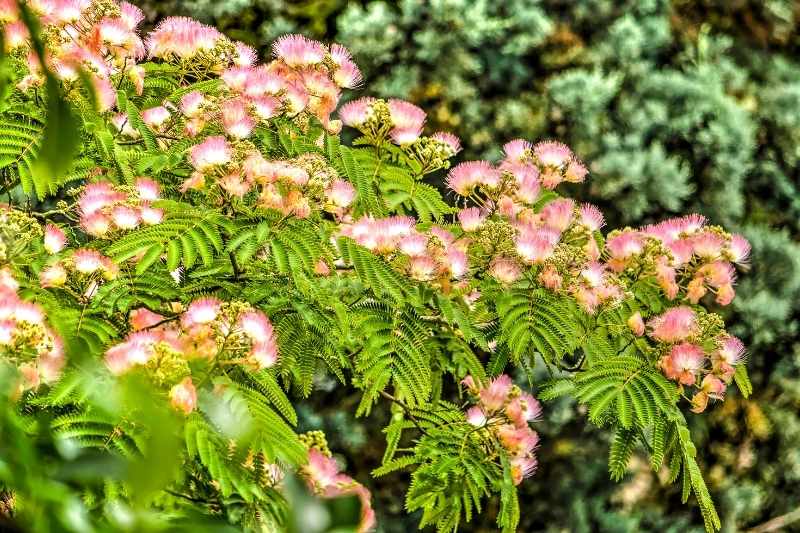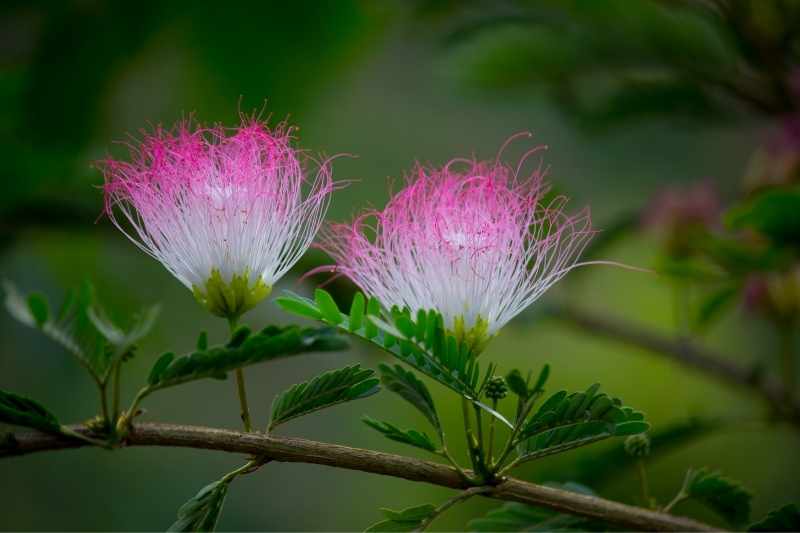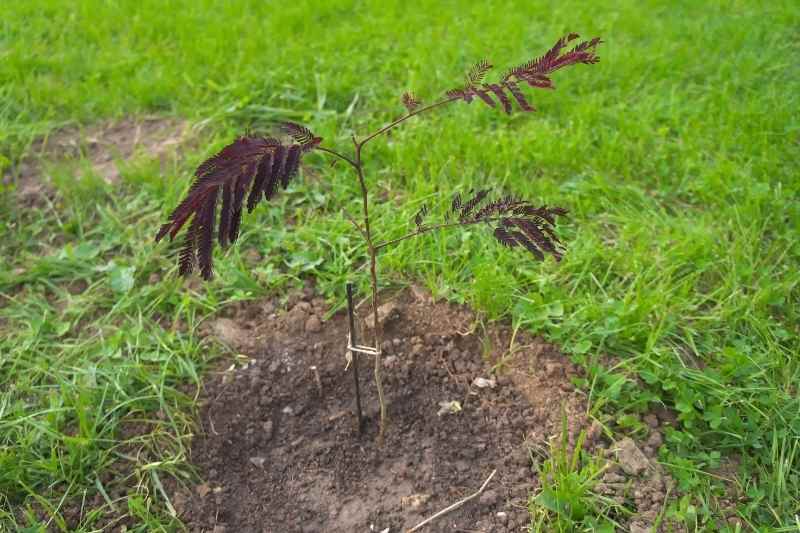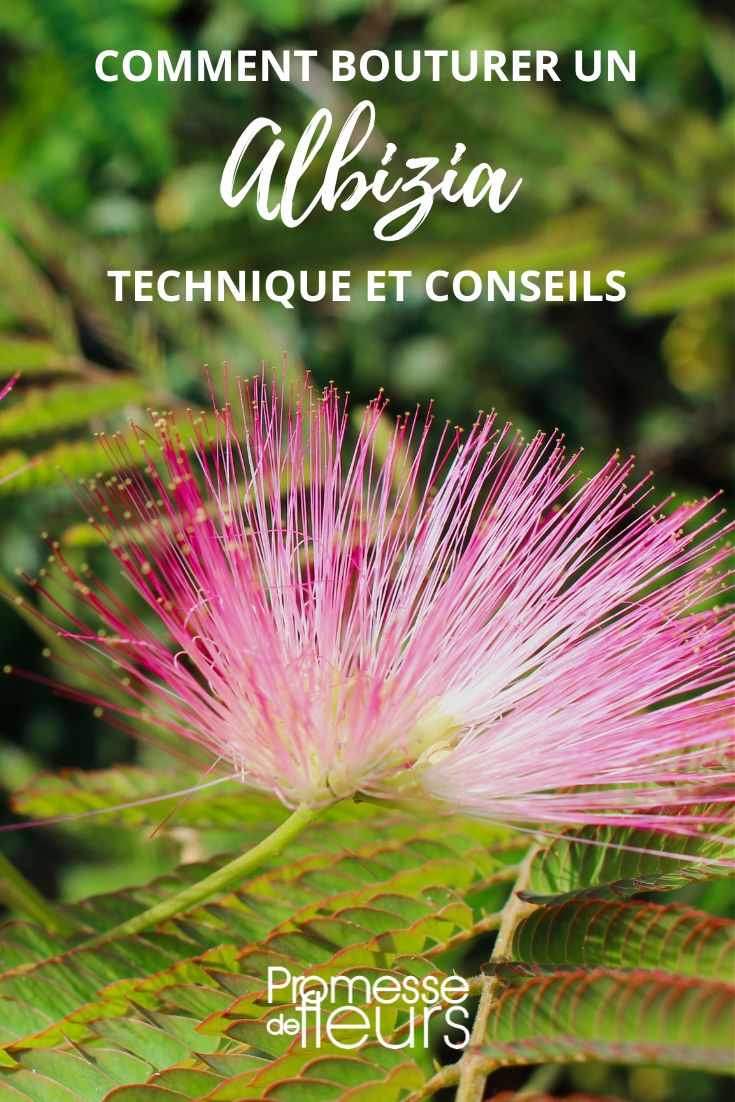Albizia, also called Silk Tree or Mimosa of Constantinople, is a very beautiful bush notable for its light umbrella-shaped habit, as in Albizia julibrissin 'Ombrella'. In summer, its finely divided foliage, green or purple like 'Summer Chocolate', reminiscent of mimosa, is covered with silky pink or red pom-poms. Easy to grow, it is a good shade-providing bush that grows in any fertile, well-drained soil, in sun and sheltered from cold winds. You can multiply your albizia by propagation by cuttings, a technique that allows faithful reproduction of horticultural varieties. Discover how to propagate albizia easily with our advice!

Albizia julibrissin
When to take an albizia cutting?
Propagation by cuttings of Albizia is carried out using cuttings in mid-summer, in July–August. Take semi-lignified or semi-hardened stems, i.e. stems beginning to turn into hard wood. The method used is the covered cutting technique. It is somewhat delicate but gives very good results.
Equipment needed to take albizia cuttings
To succeed with propagation by cuttings of albizia, you will need:
- terracotta pot or buckets
- pruning shear well sharpened, previously disinfected with 70% alcohol to avoid spreading disease
- clay pebbles
- pencil to make holes in substrate
- seed or cutting compost
- garden sand
- cloche, bottom-cut plastic bottle, simple clear plastic bag or mini greenhouse
- spray bottle
- plant hormone for cuttings or rooting activator (facultative)
How to take albizia cuttings using the covered cutting technique?
This technique consists of covering cuttings with a plastic bag or cloche to maintain a warm, humid atmosphere around the cuttings (hence term "à l'étouffée"). This will encourage rooting. Albizia cuttings are more delicate to succeed than sowing, but by following our step-by-step, it should be easy!
Prepare container
- Spread clay pebbles across bottom of container to 2–3 cm thickness to promote drainage
- Fill container with seed compost and a little sand
- Firm down lightly with hand
- Use pencil to make holes 4–5 cm deep; plan to make 4–5 albizia cuttings
- With spray bottle, moisten substrate without soaking it
Your pot is ready to welcome cuttings!
Take and prepare cutting
- Using pruning shear, take from mother plant healthy shoots at least 10 centimetres long, preferably free of flowers; select semi-lignified stems (starting to harden at base). They should bear a few leaves.
- Cut below a node
- Remove any flowers and flower buds
- Remove leaves at base of stem
- Cut remaining upper leaves in half to limit evaporation
- Scrape bark just below a node for about 1 cm
- You can dip base of stem in plant hormone for cuttings to facilitate rooting

Plant the cuttings
- Push cuttings three-quarters of their length into each hole
- Firm gently around each stem
- Cover pot with cloche, plastic bottle or plastic bag secured with an elastic to keep cuttings under cover
- Place pot in sheltered, bright spot but without direct sun
- Water regularly to keep compost slightly moist, but not waterlogged
- Ventilate regularly to avoid mould development
- After 2–3 months, when cuttings show signs of growth, remove plastic or cloche and repot young shoots into larger pots
- Place them under cold frame or in an unheated conservatory for winter
- Reduce watering: excessive moisture favours development of fungi
Plant your cuttings
Cuttings can be planted directly in ground in garden or in a large pot placed outdoors the following spring. Set young albizias in sun, in a free-draining, rather sandy soil.
During first years, young shoots remain fragile: remember to water regularly during hot spells for first two years after planting. Once mature, albizia will easily do without regular watering. It is a bush that withstands summer drought once established.

To learn more
- Discover our advice sheet: “Propagation by cuttings: everything you need to know about different techniques and our advice to succeed with your cuttings”.
































Comments